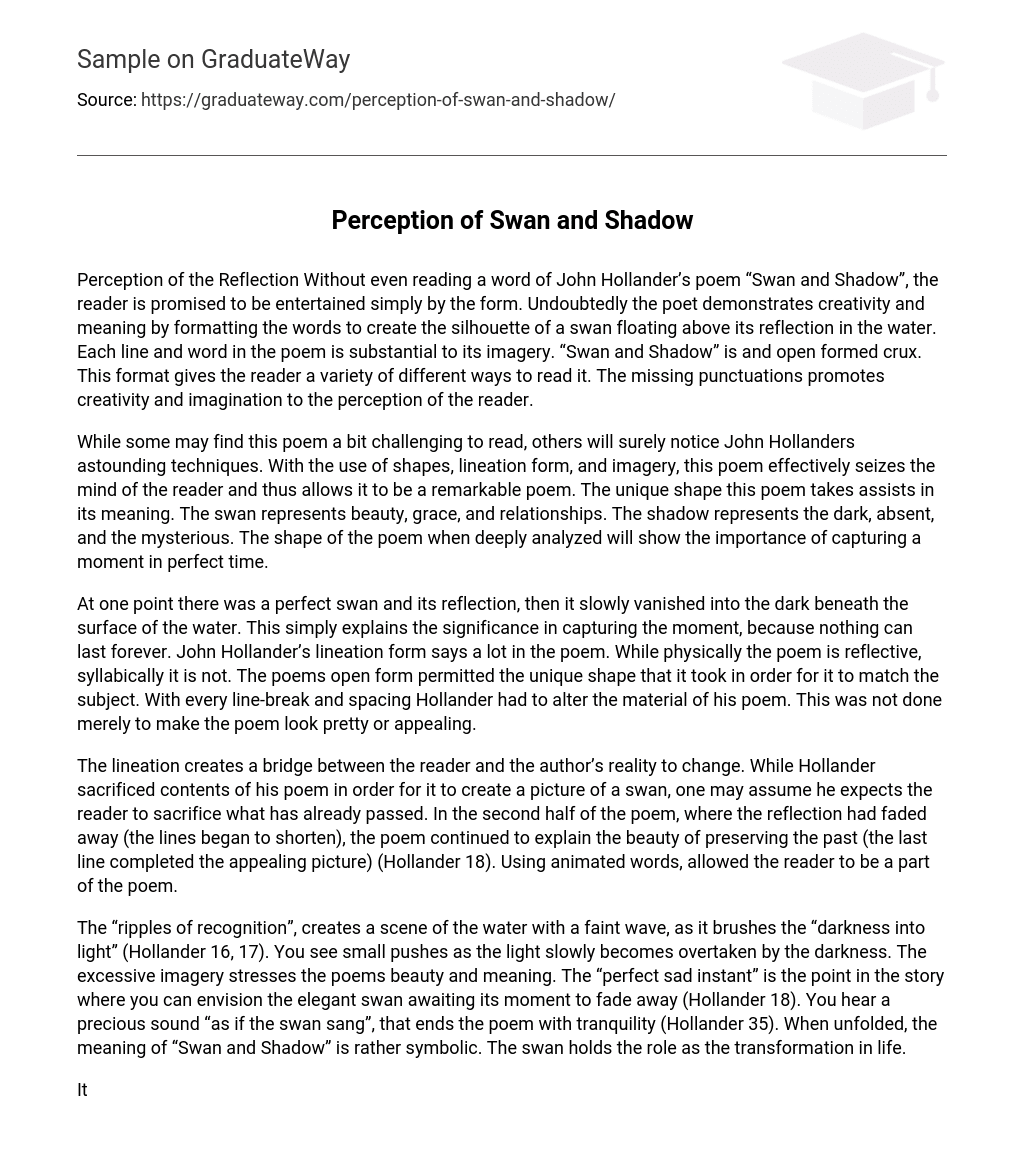Perception of the Reflection Without even reading a word of John Hollander’s poem “Swan and Shadow”, the reader is promised to be entertained simply by the form. Undoubtedly the poet demonstrates creativity and meaning by formatting the words to create the silhouette of a swan floating above its reflection in the water. Each line and word in the poem is substantial to its imagery. “Swan and Shadow” is and open formed crux. This format gives the reader a variety of different ways to read it. The missing punctuations promotes creativity and imagination to the perception of the reader.
While some may find this poem a bit challenging to read, others will surely notice John Hollanders astounding techniques. With the use of shapes, lineation form, and imagery, this poem effectively seizes the mind of the reader and thus allows it to be a remarkable poem. The unique shape this poem takes assists in its meaning. The swan represents beauty, grace, and relationships. The shadow represents the dark, absent, and the mysterious. The shape of the poem when deeply analyzed will show the importance of capturing a moment in perfect time.
At one point there was a perfect swan and its reflection, then it slowly vanished into the dark beneath the surface of the water. This simply explains the significance in capturing the moment, because nothing can last forever. John Hollander’s lineation form says a lot in the poem. While physically the poem is reflective, syllabically it is not. The poems open form permitted the unique shape that it took in order for it to match the subject. With every line-break and spacing Hollander had to alter the material of his poem. This was not done merely to make the poem look pretty or appealing.
The lineation creates a bridge between the reader and the author’s reality to change. While Hollander sacrificed contents of his poem in order for it to create a picture of a swan, one may assume he expects the reader to sacrifice what has already passed. In the second half of the poem, where the reflection had faded away (the lines began to shorten), the poem continued to explain the beauty of preserving the past (the last line completed the appealing picture) (Hollander 18). Using animated words, allowed the reader to be a part of the poem.
The “ripples of recognition”, creates a scene of the water with a faint wave, as it brushes the “darkness into light” (Hollander 16, 17). You see small pushes as the light slowly becomes overtaken by the darkness. The excessive imagery stresses the poems beauty and meaning. The “perfect sad instant” is the point in the story where you can envision the elegant swan awaiting its moment to fade away (Hollander 18). You hear a precious sound “as if the swan sang”, that ends the poem with tranquility (Hollander 35). When unfolded, the meaning of “Swan and Shadow” is rather symbolic. The swan holds the role as the transformation in life.
It moves in moderation, but eventually will not be where it was before. The fading reflection symbolizes the perfect parts of the past that most everyone tries to hold onto. John Hollander demonstrates how time is precious and we must cherish the things we have at the moment. Light represents our happiness and the dark implies sadness. Eventually the light will fade into the darkness and we will be forced to find the “perfect sad instant” (Hollander 18). The good things out of the bad, and restore from there. Works Cited Hollander, John. “Swan and Shadow. ” Selected Poems. London: Secker and Warburg, 1929. Print. .





